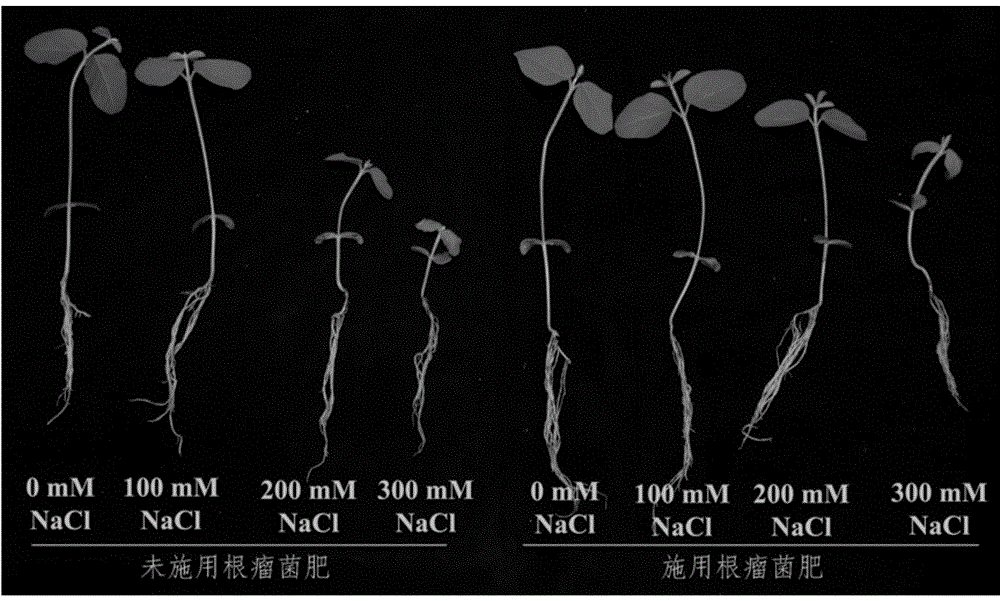Method for improving adaptive capacity of soybeans in saline-alkali soil
A technology of adaptability and saline-alkali land, applied in the direction of fertilization methods, botanical equipment and methods, applications, etc., to achieve the effect of improving expression levels and promoting expression levels
- Summary
- Abstract
- Description
- Claims
- Application Information
AI Technical Summary
Problems solved by technology
Method used
Image
Examples
Embodiment 1
[0023] Embodiment 1 Rhizobium bacterial liquid
[0024] (1) Inoculate the rhizobia colony in TY / Ca 2+ In the culture medium, incubate at 30°C, 225rpm shaker for 12 hours to obtain mother liquor; TY / Ca 2+ Culture medium composition: 5g / L tryptone, 3g / L yeast extract, 6mmol / L CaCl 2 , pH=7.2, the solvent is water.
[0025] (2) Inoculate the seed solution of step (1) to TY / Ca with an inoculum volume concentration of 0.1% 2+ Proliferate in culture medium at 30°C, 225rpm shaker for 12 hours until OD 600 When the value reaches 1.0, a rhizobia bacterial liquid is obtained.
Embodiment 2
[0027] 1) Take 50 salt-tolerant soybeans of the Wenfeng07 variety with full particles and uniform particle size, soak them in Liby bleach for 5 minutes, and rinse them with tap water for 5 minutes. Then disinfect with 75% ethanol aqueous solution for 5 minutes, rinse with double distilled water for 3 times, disinfect with 0.1% mercury liter for 10 minutes, and then wash with sterile water for 5 times until the residual mercury liter is cleaned. absorbent paper to absorb the water on the surface of the seeds, which is the sterilized seeds;
[0028] 2) Place the sterilized seeds on a petri dish lined with moist sterile filter paper, and cultivate them in the dark at 37°C for 2 to 3 days until the seeds germinate, the two cotyledons open, and the buds are 2 to 3 cm long to obtain soybeans seedling;
[0029] 3) the rhizobia bacterium liquid prepared by embodiment 1 is diluted to OD with purified water 600 is 0.001, soak the soybean seedlings obtained in step 2) in the diluted Rh...
Embodiment 3
[0038] The specific steps are the same as in Example 2, except that the soybean variety adopts the main planted salt-sensitive variety Union 85140, and other operations are the same as in Example 2. The results are shown in image 3 As shown, the results showed that the salt tolerance of plants added with rhizobia fertilizer was significantly enhanced.
PUM
 Login to View More
Login to View More Abstract
Description
Claims
Application Information
 Login to View More
Login to View More - R&D
- Intellectual Property
- Life Sciences
- Materials
- Tech Scout
- Unparalleled Data Quality
- Higher Quality Content
- 60% Fewer Hallucinations
Browse by: Latest US Patents, China's latest patents, Technical Efficacy Thesaurus, Application Domain, Technology Topic, Popular Technical Reports.
© 2025 PatSnap. All rights reserved.Legal|Privacy policy|Modern Slavery Act Transparency Statement|Sitemap|About US| Contact US: help@patsnap.com



